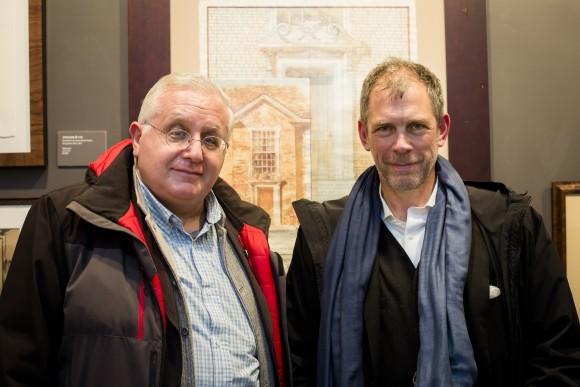NEW YORK—Since the Renaissance, architecture has been called the mother of all the arts. Traditionally, architects had to master all of the other artistic skills of drawing, painting, and sculpture before putting pencil to paper to shape the buildings and structures that would eventually shape us.
Eleventh Street Arts gallery is celebrating the art of architecture in an exhibition of 50 drawings and paintings from more than 15 of the top classically trained architects and artists today. The exhibition runs through April 7.
[gallery size=“medium” ids=“2230195,2230191,2230198,2230231,2230202”]
All of the drawings were done by hand, which has nearly become a lost practice in architectural firms.
Some of the designs have been actualized into buildings, some were drawn from finished buildings, while others have remained designs to be admired. A few of the drawings were created for teaching purposes, like that of a pilaster, drawn by architect Steve Bass. “It’s based on the conceptual attitude that the whole and the parts are designed on the same geometric theme,” said Bass, at the opening reception at Eleventh Street Arts on March 2.
[gallery ids=“2230187,2230188”]
At a time of mass produced buildings, art has been nearly wiped out in modern architecture, explained Bass. He teaches at the Institute for Classical Architecture and Art (ICAA), a nonprofit that aims to bring art back into the discipline of architecture.
“The ICAA started around 1992. I’ve seen this culture go from nothing to something, from a few isolated people like myself working on their own, to developing a whole social culture about it,” Bass said.
[gallery size=“medium” ids=“2230204,2230197,2230023”]
Anton Glikin of Peter Pennoyer Architects has created probably the most clearly rendered drawing of the Grand Central Terminal façade. He and his wife, Irina Shumitskaya, both studied at the I. Repin St. Petersburg State Academy Institute of Painting, Sculpture, and Architecture in Russia, which has continued the tradition of art in architecture without interruption. Their drawings in the exhibition show a sensitivity to a wash rendering technique that is rarely seen today.
[gallery size=“large” ids=“2230203,2230038”]
Glikin mentioned that when he walks through some buildings, he can tell whether it was drawn and designed by hand. “It feels more human,” he said. As an example, he cited the Eero Saarinen-designed terminal, originally known as the TWA Flight Center, which now sits in front of Terminal 5 at New York’s John F. Kennedy International Airport.
“In general it’s a good idea for an architect to be able to draw by hand, whether it is for a neoclassical or modern building. But for neoclassical architecture, I don’t think there is any other way to visualize an initial design other than by hand,” Glikin said.
In the creative process, drawing by hand is a one-step process of translating the architect’s vision and sentiment onto paper. Designing on a computer requires the vision of the architect to be transferred into numbers, a two-step process that is more analytical, Glikin explained.
[gallery size=“medium” ids=“2230205,2230206,2230200”]
Michael Djordjevitch of the architectural design firm Atelier & Co., featured in the exhibition, said, “We can only grow as architectural designers by engaging with the world through drawing it, through modeling it, through painting it. It does give us the raw material to intervene in it as architectural artist.”
Djordjevitch explained why architecture is considered the mother of the arts. “Architecture is a stepping back from our fundamental reality in the world and presenting it to us in some idealized way. So it is about the sky and the ground and the horizon,” he said.






